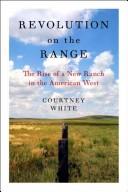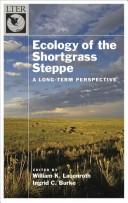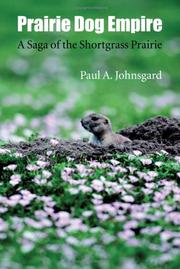| Listing 1 - 10 of 69 | << page >> |
Sort by
|
Book
ISBN: 1617280720 9781617280726 9781608765423 1608765423 Year: 2010 Publisher: New York
Abstract | Keywords | Export | Availability | Bookmark
 Loading...
Loading...Choose an application
- Reference Manager
- EndNote
- RefWorks (Direct export to RefWorks)
"Genetic diversity and species diversity are both crucial for ecosystem stability. Analysis of plant diversity aims to understand the organization and the variability of biological populations within ecosystems. This book provides a review on chemotaxonomical criteria helping to understand complex structures of plant diversity. It focuses particularly on the chemotaxonomic usefulness of phenolic compounds in analysis of chemical polymorphisms at different taxonomic levels. The relationship between grazing pressure and grassland vegetation is also examined, using drastically improved information technology such as remote sensing, Geographic Information System (GIS) and Ground Positioning Systems (GPS). Furthermore, an overview of the unique ecosystem of the South Brazilian Campos grasslands are given. The role of disturbance in maintaining Campos biodiversity and dynamics, and the importance of its conservation, is looked at as well. Other chapters in this book discuss the relationship between management and vegetation, and also suggest ways to conserve the species diversity of both plants and butterflies in semi-natural grassland."--Publisher's description.
Grasslands. --- Grassland conservation. --- Grassland ecology. --- Biodiversity conservation.
Book
Year: 2022 Publisher: London : IntechOpen,
Abstract | Keywords | Export | Availability | Bookmark
 Loading...
Loading...Choose an application
- Reference Manager
- EndNote
- RefWorks (Direct export to RefWorks)
Grasslands are of vital significance globally by covering more than one-quarter of the earth's surface. They are known by a variety of names, such as prairies, pampas, steppes, savannas, and so on, and provide feed to animals as well as serve as biodiversity reserves and catchment areas. Under the changing climate scenario, they can potentially serve as carbon sinks, which might alleviate the adverse effects of greenhouse gas emissions. This book provides fundamental knowledge of underutilized grasses of economic significance as well as discusses advancements in grasslands management for boosting their bio-productivity. There is a particular focus on state-of-the-art strategies for the restoration and conservation of grasslands in the era of changing climate.

ISBN: 1610911040 9781610911047 9781597261746 1597261742 Year: 2008 Publisher: Washington Island Press/Shearwater Books
Abstract | Keywords | Export | Availability | Bookmark
 Loading...
Loading...Choose an application
- Reference Manager
- EndNote
- RefWorks (Direct export to RefWorks)
In Revolution on the Range, Courtney White challenges the conventional wisdom that those who wanted to work the land and those who wanted to protect it had fundamentally different--and irreconcilable--values. He argues that ranchers and environmentalists have more in common than they've typically admitted: a love of wildlife, a deep respect for nature, and a strong allergic reaction to suburbanization. The real conflict has not been over ethics, but approaches. As ranchers and environmentalists find common cause, they're discovering new ways to live on--and preserve--the land they both love. Revolution on the Range is the story of that journey, and a heartening vision of the new American West.
Periodical
Year: 1991 Publisher: [Big Sur, CA] : California Native Grass Association,
Abstract | Keywords | Export | Availability | Bookmark
 Loading...
Loading...Choose an application
- Reference Manager
- EndNote
- RefWorks (Direct export to RefWorks)
Grassland conservation --- Grasses --- California.
Book
Year: 2011 Publisher: [Place of publication not identified] : Project Gutenberg,
Abstract | Keywords | Export | Availability | Bookmark
 Loading...
Loading...Choose an application
- Reference Manager
- EndNote
- RefWorks (Direct export to RefWorks)
A historical good cowboy and cowgirltale for young people.
Ranch life. --- Vacations --- Grassland fires.

ISBN: 0197561632 1281718076 9786611718077 0199722803 9780199722808 9780195135824 0195135822 0195135822 Year: 2008 Publisher: Oxford ; New York : Oxford University Press,
Abstract | Keywords | Export | Availability | Bookmark
 Loading...
Loading...Choose an application
- Reference Manager
- EndNote
- RefWorks (Direct export to RefWorks)
Ecology of the Shortgrass Steppe: A Long-Term Perspective summarizes and synthesizes more than 60 years of research that has been conducted throughout the shortgrass region. The shortgrass steppe was an important focus of the International Biological Programme's Grassland Biome project that ran from the late 1960's until the mid 1970's. The work conducted by the Grassland Biome project was preceded by almost 40 years of research by U.S. Department of Agriculture researchers - primarily from the Agricultural Research Service - and followed to the present by the Shortgrass Steppe Long Term Ecological Research project. Ecology of the Shortgrass Steppe is an enormously rich source of data and insight into the structure and function of a semiarid grassland.
Grassland ecology --- Steppe ecology --- Ecology --- Grasslands

ISBN: 128046593X 9786610465934 0803205147 0803226047 0803254873 9780803205147 6610465932 Year: 2005 Publisher: Lincoln University of Nebraska Press
Abstract | Keywords | Export | Availability | Bookmark
 Loading...
Loading...Choose an application
- Reference Manager
- EndNote
- RefWorks (Direct export to RefWorks)
"An indispensable and highly readable introduction to the ecosystem of the shortgrass prairie, Prairie Dog Empire describes in clear and detailed terms the habitat and habits of black-tailed prairie dogs; their subsistence, seasonal behavior, and the makeup of their vast colonies; and the ways in which their "towns" transform the surrounding terrain - for better or worse. Paul A. Johnsgard recounts how this terrain was in turn transformed over the past century by the destruction of prairie dogs and their grassland habitats, together with the removal of the bison and their replacement with domestic livestock. A disturbing look at profound ecological alterations in the environment, this book also offers a rare and invaluable close-up view of the rich history and threatened future of the creature once considered the "keystone" species of the western plains." "Included are maps, drawings, and listings of more than two hundred natural grassland preserves where many of the region's native plants and animals may still be seen and studied."--Jacket.
Prairie ecology --- Prairie animals --- Ecology --- Earth & Environmental Sciences --- Prairie fauna --- Prairies --- Grassland animals --- Grassland ecology
Periodical
Abstract | Keywords | Export | Availability | Bookmark
 Loading...
Loading...Choose an application
- Reference Manager
- EndNote
- RefWorks (Direct export to RefWorks)
Grasslands --- Grassland ecology --- Ecology --- Grass lands --- Lands, Grass --- Grasses --- Grassland ecology. --- Grasslands.
Book
ISBN: 9783031232657 Year: 2023 Publisher: Cham Springer International Publishing :Imprint: Springer
Abstract | Keywords | Export | Availability | Bookmark
 Loading...
Loading...Choose an application
- Reference Manager
- EndNote
- RefWorks (Direct export to RefWorks)
This book offers a series of interviews with Canadian ranchers that highlight the innovative and effective ways that they manage vast swaths of grassland for two complementary goals: commercial viability and sustainable habitats. The book’s author is an academic who grew up among ranchers in the grasslands of Canada, and the expertise and viewpoints she has distilled from these interviews complement the academic literature in accessible and surprising ways . As these productive landscapes face increasingly perilous threats such as development, economic pressures, and extreme weather events, it is the ranchers who live on and manage these native grasslands who are passionate about conserving them. This book is about them, their experiences and the realities of their lives, their view of the world, sharing their knowledge to assist younger ranchers, and their contributions to Canada’s species at risk conservation goals, food security and economy. The book offers practical advice for ranchers, but also reveals the depth of attachment and dedication these ranchers have for the grasslands. They are conservationists at heart, as they not only understand that their livelihood is dependent on the health of the ecosystem they manage, but they also have a deep connection to the land, nurtured oftentimes for many generations. Academics and ranchers have much to learn here, but the book – most of which is the words of the ranchers themselves - is written to give the general public an understanding of this vocation and its role in the conservation of our last remaining grasslands.
Environmental management. --- Sustainability. --- Grassland ecology. --- Environmental Management. --- Grassland Ecology. --- Ranchers --- Range management
Book
ISBN: 3031394844 3031394852 Year: 2023 Publisher: Cham : Springer International Publishing : Imprint: Springer,
Abstract | Keywords | Export | Availability | Bookmark
 Loading...
Loading...Choose an application
- Reference Manager
- EndNote
- RefWorks (Direct export to RefWorks)
This book comprehensively covers the topics of origin and distribution, evolution and types, regional and global importance, biodiversity conservation, plant-soil interfaces, ecosystem functions and services, social-ecological systems, climate change adaptations, land degradation and restoration, grazing management and pastoral production, and sustainable future of the grasslands on the Qinghai-Tibetan Plateau (QTP), which is a globally unique eco-region called the "Roof of the World" because of its high elevation, “Third Pole on Earth" because of its alpine environment and the "Water Tower in Asia" because of its headwater location. The grassland ecosystem covers above 60% of QTP, which is about 2.5 million km2, 1/4 of Chinese total territorial lands. The grassland ecosystem of the QTP (the Third Pole) is an important part of the palaearctic region, which features alpine cover and low oxygen. The Third Pole's grasslands not only provide important ecosystem functions such as biodiversity conservation, carbon storage, water resource regulation, climate control, and natural disaster mitigation at a global scale, but also provide critical ecosystem services such as pastoral production, cultural inheritance, and tourism and recreation at local and regional scales. The purposes of this monograph are to address the following questions: (1) What are the special features of the Third Pole's grasslands? (2) How have climate changes and human activities changed the structures and functions of the Third Pole's grasslands? (3) How can we cope with land degradation and climate change through innovative restoration and protective actions for Third Pole's grasslands? And (4) How can we promote the sustainable development of social-ecological systems of the Third Pole's grasslands through best management practices including grazing? The goal of this book is to attract the attention of international audiences to realize the importance of the Third Pole’s grasslands, and to call for the actions of global communities to effectively protect and sustainably use the Third Pole's grasslands. This book can be served as textbooks, teaching materials and documentaries for different audiences. The target audiences include students, teachers, researchers, policy makers, planners, government officials, and NGOs in agricultural, environmental and natural resources sectors.
Environmental sciences --- Grassland ecology. --- Environmental management. --- Environmental Social Sciences. --- Grassland Ecology. --- Environmental Management. --- Social aspects.
| Listing 1 - 10 of 69 | << page >> |
Sort by
|

 Search
Search Feedback
Feedback About UniCat
About UniCat  Help
Help News
News